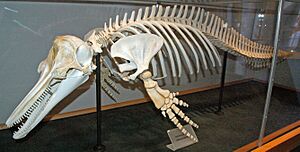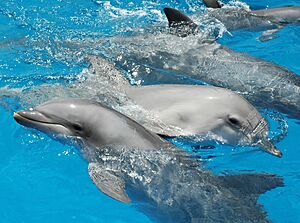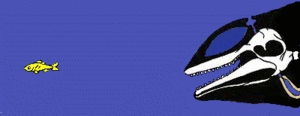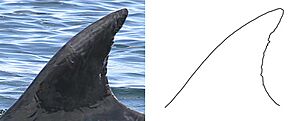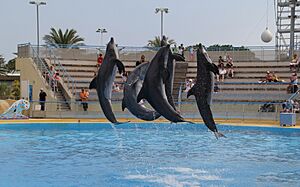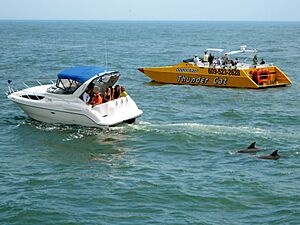Common bottlenose dolphin facts for kids
{{Speciesbox | name = Common bottlenose dolphin | image = Tursiops truncatus 01-cropped.jpg | image_caption = Common bottlenose dolphin breaching surfing a boat wake, a frequently seen activity in high traffic areas | image2 = Bottlenose dolphin size.svg | image2_caption = Size compared to an average human | status = LC | status_system = IUCN3.1 | status_ref = | status2 = CITES_A2 | status2_system = CITES | status2_ref = | genus = Tursiops | species = truncatus | authority = (Montagu, 1821) | subdivision_ranks = Subspecies | subdivision_ref = | subdivision = *T. t. truncatus
- T. t. ponticus
- T. t. gephyreus
- T. t. nuuanu
| range_map = Cypron-Range Tursiops truncatus.svg | range_map_caption = Common bottlenose dolphin range (in blue)
| synonyms =
- 'Delphinus tursio' Gunnerus, 1768
- 'Tursiops tursio' Bonnaterre, 1789
- 'Delphinus nesarnack' Lacépède, 1804
- 'Delphinus truncatus' Montagu, 1821
- 'Phocoena compressicauda' Lesson, 1828
- 'Delphinus catalania' Gray, 1844
- 'Tursiops communis' Fitzing, 1846
- 'Delphinus compressicauda' Gray, 1846
- 'Delphinus cymodoce' Gray, 1846
- 'Delphinus eurynome' Gray, 1846
- 'Delphinus metis' Gray, 1846
- 'Tursiops eurynome' Gray, 1846
- 'Delphinus erebennus' Cope, 1865
- 'Tursio catalania' Gray, 1866
- 'Tursio cymodoce' Gray, 1866
- 'Tursio eurynome' Gray, 1866
- 'Tursio metis' Gray, 1866
- 'Tursio truncatus' Gray, 1866
- 'Tursio compressicauda' Gray, 1866
- 'Tursiops parvimanus' Van Beneden, 1886
- 'Tursiops coerulescens' Giglioli, 1889
- 'Tursiops compressicauda' Trouessart, 1898
- 'Tursiops gephyreus' Lahille, 1908
- 'Tursiops dawsoni' Lydekker, 1909
- 'Tursiops nuuanu' Andrews, 1911
- 'Tursiops maugeanus' Iredale & Troughton, 1934
- 'Tursiops ponticus' Barabash-Nikiforov, 1940
The common bottlenose dolphin (Tursiops truncatus) is a well-known type of dolphin. You might have seen them in movies or at marine parks. They live in warm and tropical oceans all over the world.
These dolphins are very famous. They are known for their playful nature and intelligence. Scientists are still learning about the different kinds of bottlenose dolphins.
Contents
About Bottlenose Dolphins
Common bottlenose dolphins are usually grey. They have a short snout that looks a bit like a bottle. This is how they got their name. They also have a single blowhole on top of their heads.
These dolphins are between 2 and 4 meters (6.5 to 13 feet) long. They weigh between 150 and 650 kilograms (330 to 1,430 pounds). Male dolphins are typically larger and heavier than females.
Unlike many other dolphins, their necks are quite flexible. This is because five of their neck bones are not fused together.
Different Kinds of Bottlenose Dolphins
For a long time, all bottlenose dolphins were thought to be one species. But in 1998, scientists realized that the Indo-Pacific bottlenose dolphin is a separate species. These two species likely split about 1 million years ago.
Today, scientists recognize a few different types of common bottlenose dolphins. These include the Black Sea bottlenose dolphin. Researchers are still studying these groups. They want to see if some might be different species. For example, a recent study found that coastal dolphins off North America are a distinct species. They are now called Tamanend's bottlenose dolphin.
Dolphin Intelligence
Bottlenose dolphins have very large brains. They are known for being very smart. Scientists have studied how they mimic things. They also look at how dolphins use special languages. Dolphins can even recognize themselves in a mirror.
Their intelligence helps them interact with humans. They are popular in shows and TV programs like Flipper. The U.S. Navy has even trained them. They help find sea mines or spot enemy divers. In some places, dolphins work with fishermen. They help herd fish into nets and then eat the fish that escape.
Life and Behavior
Bottlenose dolphins are very social animals. They live in groups called pods. A pod usually has about 15 dolphins. But sometimes, groups can be much larger. They can even have over 1,000 animals for short times.
Dolphins form different types of groups. There are groups for mothers and their young. There are also groups for young dolphins. Adult males often form strong pairs. Female dolphins stay with their calves for several years.
How Dolphins Use Echolocation
Dolphins use their blowholes and nasal sacs to make sounds. They also use a special organ called a melon for echolocation. Echolocation is like using sonar. Dolphins send out sound waves. These waves bounce off objects and come back to the dolphin.
Their brains interpret these sounds. This helps them know where objects are. They can tell the shape and size of things. Echolocation helps them navigate, communicate, and hunt. It also helps them avoid predators. Lower frequency sounds travel best in water. This makes them great for echolocation.
What Dolphins Eat
Common bottlenose dolphins eat many things. Their diet includes eels, squid, shrimp, and various fish. They do not chew their food. Instead, they swallow it whole.
Dolphin pods often work together to catch schools of fish. They can also hunt alone. They use echolocation to find their prey. The types of fish they eat depend on where they live. For example, off the U.S. Atlantic coast, they eat fish like Atlantic croakers. In South Africa, they eat different kinds of fish.
Dolphins have clever hunting methods. They might circle a school of fish. Then they use echolocation to pick them off one by one. They can also stun fish with sonar. Sometimes, they even smash fish into corals. A dolphin eats about 10-20% of its body weight each day. Pregnant and nursing females eat the most.
How Dolphins Communicate
Dolphins use sounds to talk to each other. They make squeaks from their blowholes. They also make whistles from nasal sacs. Dolphins also use body language. They might leap from the water. They also slap their tails on the water.
Dolphins have unique "signature whistles." These are like their names. They use them to call to each other.
When dolphins interact, they sometimes grab each other with their teeth. This creates unique marks on their dorsal fins. These marks are like fingerprints. Scientists use them to identify individual dolphins. This helps them study dolphins around the world.
Dolphin "Baby Talk"
Mother dolphins change their signature whistles when their calves are nearby. They make their whistles higher in pitch. They also use a wider range of frequencies. This is similar to how humans use "baby talk" when speaking to infants.
Scientists think this helps the calf pay attention. It also helps with bonding between mother and calf. This behavior might also help the young dolphins learn to make sounds. This is a rare discovery in other animal species.
How Dolphins Reproduce
Bottlenose dolphins mate with many partners. They can breed all year. But it happens most often in the spring. The mother carries the baby for about 12 months. So, mating and birthing seasons overlap.
Males form groups to find females ready to mate. They try to keep other males away. Females give birth to one calf every three to six years. Newborn calves are about 0.8 to 1.4 meters (2.6 to 4.6 feet) long. They weigh between 15 and 30 kilograms (33 to 66 pounds).
Calves drink milk from their mothers for 18 to 20 months. They are fully weaned between three and eight years old. Females usually reproduce every 3 to 6 years. Dolphins reach maturity between 5 and 14 years old. Males mature between 8 and 13 years. Females mature between 5 and 10 years.
How Long Dolphins Live
Common bottlenose dolphins usually live for at least 40 years. Some can live up to 60 years. Females often live longer than males. In captivity, they have been known to live up to 51 years.
The dangers to dolphins depend on where they live. Dolphins in shallow coastal waters are often top predators. But young dolphins need protection from sharks. Dolphins in the deep ocean face more shark attacks. Living in pods helps them survive. Other predators, like stingrays and orcas, mainly affect newborns.
Where Dolphins Live
Dolphins live in every ocean. They can also be found in some rivers and other water areas. Common bottlenose dolphins prefer warmer ocean regions. They live in temperate, subtropical, and tropical oceans worldwide. There are about 600,000 common bottlenose dolphins globally.
Some dolphin groups live close to the shore. These are called inshore populations. Others live further out at sea. These are offshore populations. Offshore dolphins are usually larger and darker. They also have shorter fins and beaks.
Offshore dolphins can travel long distances. They can migrate up to 4,200 kilometers (2,600 miles) in a season. Inshore dolphins usually move less. But some inshore groups migrate during El Niño events. Coastal dolphins adapt to warm, shallow waters. They have smaller bodies and larger flippers. This helps them move easily and release heat. They can be found in harbors, bays, and estuaries. Offshore dolphins are suited for cooler, deeper waters. Their larger bodies protect them from predators. It also helps them stay warm.
Dolphins and Humans
Humans and dolphins interact in many ways. Some interactions can be harmful to dolphins.
Dolphin hunting happens in some countries. For example, common bottlenose dolphins are hunted for food in Taiji, Japan. They are also hunted in the Faroe Islands. Dolphins can also be accidentally caught in fishing nets. This is called bycatch. It often happens during tuna fishing.
Sometimes, individual dolphins become famous. Tião was a male dolphin in Brazil. He was first seen around 1994. He often let humans interact with him. But later, he became known for hurting swimmers.
Fungie was another famous male dolphin. He lived in Dingle Harbour, Ireland, from 1983 to 2020. He was very friendly with humans. Fungie became a symbol of the town.
Protecting Dolphins
Many groups are working to protect common bottlenose dolphins. Populations in the North Sea, Baltic, Mediterranean, and Black Sea are especially important. They are listed under a special agreement. This agreement helps protect animals that migrate.
International trade of dolphins is also controlled. This includes their body parts. This is done through the Convention on International Trade in Endangered Species (CITES).
Here are some estimated populations in different areas:
| Area | Population |
|---|---|
| Northern Gulf of Mexico | 97,964 |
| Eastern coast of North America | 110,000 |
| Eastern Tropical Pacific | 243,500 |
| Hawaiian Islands | 3,215 |
| Coastal of California | 345 |
| Japan | 36,791 |
| Eastern Sulu Sea | 2,628 |
| Western European continental shelf | 12,600 |
| Mediterranean Sea | fewer than 10,000 |
| Black Sea | at least several thousand |
There are also agreements to protect small whales and dolphins. These include agreements for the Baltic, North East Atlantic, Irish, and North Seas. Other agreements cover the Black Sea, Mediterranean Sea, and Pacific Islands.
Ocean Pollution
Marine pollution is a big threat to dolphins. Common bottlenose dolphins live in coastal areas. They are top predators there. This means they can show us how healthy the ocean is.
Some dolphin diseases are linked to human actions. Water pollution is a major cause. This pollution can come from single sources. An oil spill is an example of a single source. The environmental impact of the Deepwater Horizon oil spill affected dolphins for a long time. Dolphins use these areas for giving birth and finding food. Chemicals and pollution can harm their bodies. This affects future dolphin populations.
Oil spills have been linked to lung and reproductive problems in female dolphins. A study looked at dolphins in Barataria Bay, Louisiana. Many had lung disease. Out of 10 pregnant dolphins, only 20% had healthy calves. Before the oil spill, 83% had healthy calves. Scientists believe the oil spill caused these low numbers.
Pollution also comes from many sources. This is called non-point source pollution. For example, too many chemicals from farms can enter the water. This causes too much algae to grow. When the algae die, they use up oxygen. This creates "dead zones" in the water.
Harmful algal blooms also cause problems. These blooms produce toxins. Dolphins can get sick or even die from eating fish with these toxins. These toxins can harm their breathing and nervous systems.
See also
- List of cetaceans
- Unihemispheric slow-wave sleep


